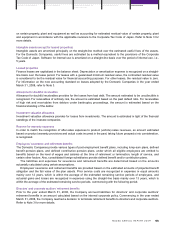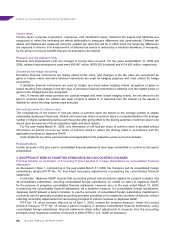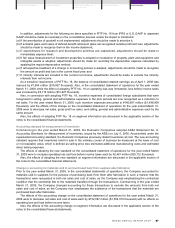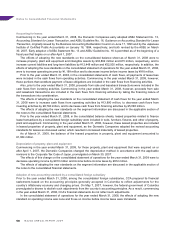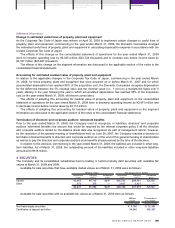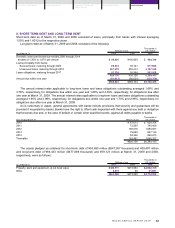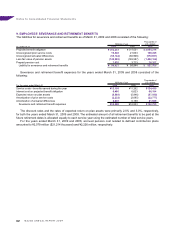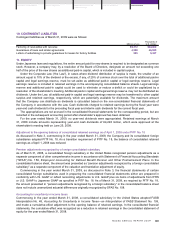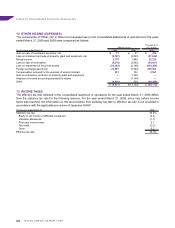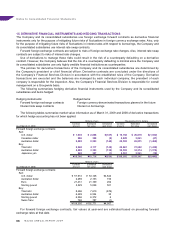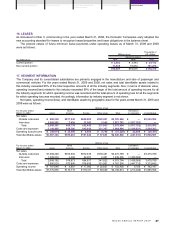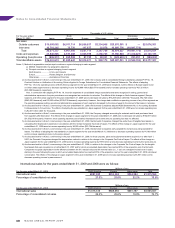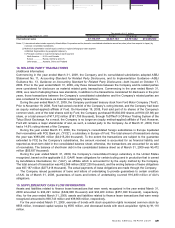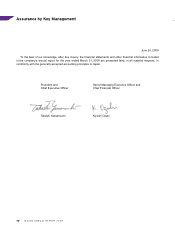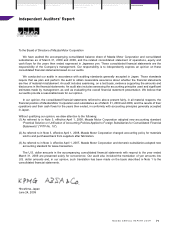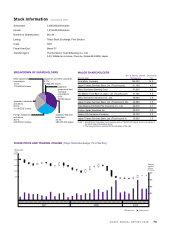Mazda 2009 Annual Report Download - page 65
Download and view the complete annual report
Please find page 65 of the 2009 Mazda annual report below. You can navigate through the pages in the report by either clicking on the pages listed below, or by using the keyword search tool below to find specific information within the annual report.
Review of OperationsMessages from Management Mazda’s Environmental and
Safety Technology
Corporate Information Financial Section
10. CONTINGENT LIABILITIES
Contingent liabilities as of March 31, 2009 were as follows:
Thousands of
Millions of yen U.S. dollars
Factoring of receivables with recourse ¥4,312 $44,000
Guarantees of loans and similar agreements 4,508 46,000
Letters of undertaking to provide guarantees for leases for factory facilities 525 5,357
11. EQUITY
Under Japanese laws and regulations, the entire amount paid for new shares is required to be designated as common
stock. However, a company may, by a resolution of the Board of Directors, designate an amount not exceeding one
half of the price of the new shares as additional paid-in capital, which is included in capital surplus.
Under the Corporate Law (“the Law”), in cases where dividend distribution of surplus is made, the smaller of an
amount equal to 10% of the dividend or the excess, if any, of 25% of common stock over the total of additional paid-in
capital and legal earnings reserve, must be set aside as additional paid-in capital or legal earnings reserve. Legal
earnings reserve is included in retained earnings in the accompanying consolidated balance sheets. Legal earnings
reserve and additional paid-in capital could be used to eliminate or reduce a deficit or could be capitalized by a
resolution of the shareholder’s meeting. Additional paid-in capital and legal earnings reserve may not be distributed as
dividends. Under the Law, all additional paid-in capital and legal earnings reserve may be transferred to other capital
surplus and retained earnings, respectively, which are potentially available for dividends. The maximum amount
that the Company can distribute as dividends is calculated based on the non-consolidated financial statements of
the Company in accordance with the Law. Cash dividends charged to retained earnings during the fiscal year were
year-end cash dividends for the preceding fiscal year and interim cash dividends for the current fiscal year.
The appropriations are not accrued in the consolidated financial statements for the corresponding period, but are
recorded in the subsequent accounting period after shareholder’s approval has been obtained.
For the year ended March 31, 2009, no year-end dividends were appropriated. Retained earnings at March
31, 2008 include amounts representing year-end cash dividends of ¥4,228 million, which were approved at the
shareholder’s meeting held on June 25, 2008.
Adjustment to the opening balance of consolidated retained earnings as of April 1, 2008 under PITF No. 18
As discussed in Note 3, commencing in the year ended March 31, 2009, the Company and its consolidated foreign
subsidiaries adopted PITF No. 18. As a transition requirement of PITF No. 18, the balance of consolidated retained
earnings as of April 1, 2008 was reduced.
Pension adjustments recognized by a foreign consolidated subsidiary
As of March 31, 2008, a consolidated foreign subsidiary in the United States recognized pension adjustments as a
separate component of other comprehensive income in accordance with Statement of Financial Accounting Standards
(“SFAS”) No. 158, Employers’ Accounting for Defined Benefit Pension and Other Postretirement Plans. In the
consolidated balance sheet, the amount was presented as “pension adjustments recognized by a foreign consolidated
subsidiary” as a separate component of the valuation and translation adjustment of equity.
Commencing in the year ended March 31, 2009, as discussed in Note 3, the financial statements of certain
consolidated foreign subsidiaries used in preparing the consolidated financial statements either are prepared in
conformity with U.S. GAAP or reflect reconciling adjustments to U.S. GAAP plus six items of adjustments from IFRS
or U.S. GAAP to Japanese GAAP as specified in PITF No. 18. As of March 31, 2009, as required by PITF No. 18,
the amount presented in “pension adjustments recognized by a foreign subsidiary” in the consolidated balance sheet
does not include unamortized actuarial differences originally recognized by SFAS No. 158.
Accounting for uncertainty in income taxes
Commencing in the year ended March 31, 2008, a consolidated subsidiary in the United States adopted FASB
Interpretation No. 48, Accounting for Uncertainty in Income Taxes—an Interpretation of FASB Statement No. 109,
and made a cumulative-effect adjustment to the opening balance of retained earnings. In the consolidated financial
statements, the cumulative-effect was recognized as a reduction in retained earnings in the consolidated statement of
equity for the year ended March 31, 2008.
63




